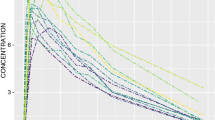Abstract
The publication of a seminal article on nonlinear mixed-effect modeling led to a revolution in pharmacokinetics (PKs) with the introduction of the population approach. Since then, interest in obtaining accurate and precise estimates of population PK parameters has led to work on population PK study design that extended previous work on optimal sampling designs for individual PK parameter estimation. The issues and developments in the design of population PK studies are reviewed as a prelude to investigating, via simulation, the performance of 2 approaches (population Fisher information matrix D-optimal design and informative block [profile] randomized [IBR] design) for designing population PK studies. The results of our simulation study indicate that the designs based on the 2 approaches yielded efficient parameter estimates. The designs based on the 2 approaches performed similarly, and in some cases designs based on the IBR approach were slightly better. The ease with which the IBR designs can be generated makes them preferable in drug development, where pragmatism and time are of great consideration. We, therefore, refer to the IBR designs as pragmatic designs. Pragmatic designs that achieve high efficiency in the estimation parameters should be used in the design of population PK studies, and simulation should be used to determine the efficiency of the designs.
Similar content being viewed by others
References
Sheiner LB, Rosenberg B, Marathe VV. Estimation of population characteristics of population pharmacokinetic parameters from routine clinical data.J Pharmacokinet Biopharm. 1977;5:445–479.
Beal SL, Sheiner LB. Estimating population pharmacokinetics.Crit Rev Biomed Eng. 1982;8:195–222.
United States Food and Drug Administration. Guidance for Industry: Population Pharmacokinetics. Washington, DC: United States Food and Drug Administration; 1999.
Sheiner LB, Beal SL. Evaluation of methods for estimating population pharmacokinetic parameters III. Monoexponential model: Clinical pharmacokinetic data.J Pharmacokinet Biopharm. 1983;11:303–319.
al-Banna MK, Kelman AW, Whiting B. Experimental design and efficient parameter estimation in population pharmacokinetics.J Pharmacokinet Biopharm. 1990;18:347–360.
Hashimoto Y, Sheiner LB. Designs for population pharmacodynamics: Value of pharmacokinetic data and population analysis.J Pharmacokinet Biopharm. 1991;19:333–353.
Ette EI. Efficient parameter estimation in preclinical animal pharmacokinetics. PhD Thesis. University of Glasgow, Glasgow, Scotland, 1991.
Ette EI, Kelman AW, Howie CA, Whiting B. Efficient experimental design and estimation of population pharmacokinetic parameters in preclinical animal studies.Pharm Res. 1995;12:729–737.
Endrenyi L. Design of experiments for estimating enzyme and pharmacokinetic experiments. In: Endrenyi L, ed.Kinetic Data Analysis of Enzyme and Pharmacokinetic Experiments. New York: Plenum Press, 1981;137–167.
D'Argenio DZ. Optimal sampling times for pharmacokinetic experiments.J Pharmacokinet Biopharm. 1981;9:739–756.
Mori F, Di Stephano JJ III. Optimal nonuniform sampling interval and test-input design for identification of physiological systems from very limited data.IEEE Trans auto Control. 1979;AC-24:893–900.
Landaw EM. Optimal design for individual parameter estimation in pharmacokinetics. In: Rowland M, Sheiner L, Steimer JL, eds.Variability in Drug Therapy: Description, Estimation, and Control. New York: Raven Press, 1985;187–200.
D'Argenio DZ, Shumitzky A. ADAPT II User's Guide:Pharmacokinetic/Pharmacodynamic Systems Analysis Software. Los Angeles, CA: Biomedical Simulations Resource; 1997.
D'Argenio DZ. Incorporating prior parameter uncertainty in the design of sampling schedules for pharmacokinetic parameter estimation experiments.Math Biosci. 1990;99:105–118.
Tod M, Padoin C, Louchahi K, Moreau-Tod B, Petitjean O, Perret G. Implementation of OSPOP, an algorithm for the estimation of optimal sampling times by the ED, EID, and API criteria.Comp Method Prog Biomed. 1996;50:13–22.
Wang J, Endrenyi L. A computationally efficient approach for the design of population pharmacokinetic studies.J Pharmacokinet Biopharm. 1992;20:279–294.
Ette EI, Sun H, Ludden TM. Design of population pharmacokinetic studies.Proc Am Stat Assoc (Biopharmaceutics Section). 1994;487–492.
Fadiran EO, Jones CD, Ette EI. Designing population pharmacokinetic studies: Performance of mixed designs.Eur J Drug Metab Pharmacokinet. 2000;25:231–239.
Jonsson EN, Wade JR, Karlsson MO. Comparison of some practical sampling strategies for population pharmacokinetic studies.J Pharmacokinet Biopharm. 1996;24:245–263.
Sun H, Ette EI, Ludden TM. On the recording of sample times and parameter estimation from repeated measures of pharmacokinetic data.J Pharmacokinet Biopharm. 1996;24:637–650.
Mentre F, Mallet A, Baccar D. Optimal design in random-effects regression models.Biometrika. 1997;84:429–442.
Tod M, Mentre F, Merle Y, Mallet A. Robust optimal design for the estimation of hyperparameters in population pharmacokinetics.J Pharmacokinet Biopharm. 1998;26:689–716.
Retout S, Mentre F. Further developments of the Fisher information matrix in nonlinear mixed effects models with evaluation in population pharmacokinetics.J Biopharm Stat. 2003;13:209–227.
Duffull SB, Retout S, Mentre F. The use of simulated annealing for finding optimal population designs.Comput Methods Programs Biomed. 2001;69:25–35.
Hooker AC, Foracchia M, Dobbs MG, Vicini P. An evaluation of population D-optimal designs via pharmacokinetic simulations.Ann Biomed Eng. 2003;31:98–111.
Retout S, Mentre F, Bruno R. Fisher information matrix for non-linear mixed-effects models: evaluation and application for optimal design of enoxaparin population pharmacokinetics.Stat Med. 2002;21:2623–2639.
Retout S, Mentre F. Optimization of individual and population designs using Splus.J Pharmacokinet Pharmacodyn. 2003;30:417–443.
Ette EI, Sun H, Ludden TM. Balanced designs in longditudinal population pharmacokinetic studies.J Clin Pharmacol. 1998;38:417–423.
Aarons L, Balant LP, Mentre F, et al. Practical experience and issues in designing and performing population pharmacokinetic/pharmacodynamic studies.Eur J Clin Pharmacol. 1996;49:251–254.
Author information
Authors and Affiliations
Corresponding author
Additional information
Published: October 5, 2005
Rights and permissions
About this article
Cite this article
Roy, A., Ette, E.I. A pragmatic approach to the design of population pharmacokinetic studies. AAPS J 7, 41 (2005). https://doi.org/10.1208/aapsj070241
Received:
Accepted:
DOI: https://doi.org/10.1208/aapsj070241




